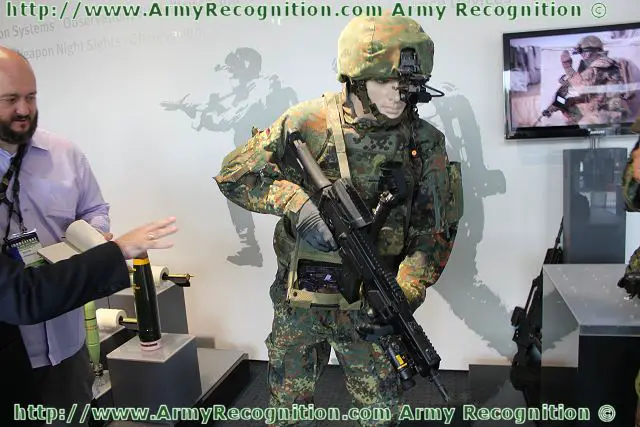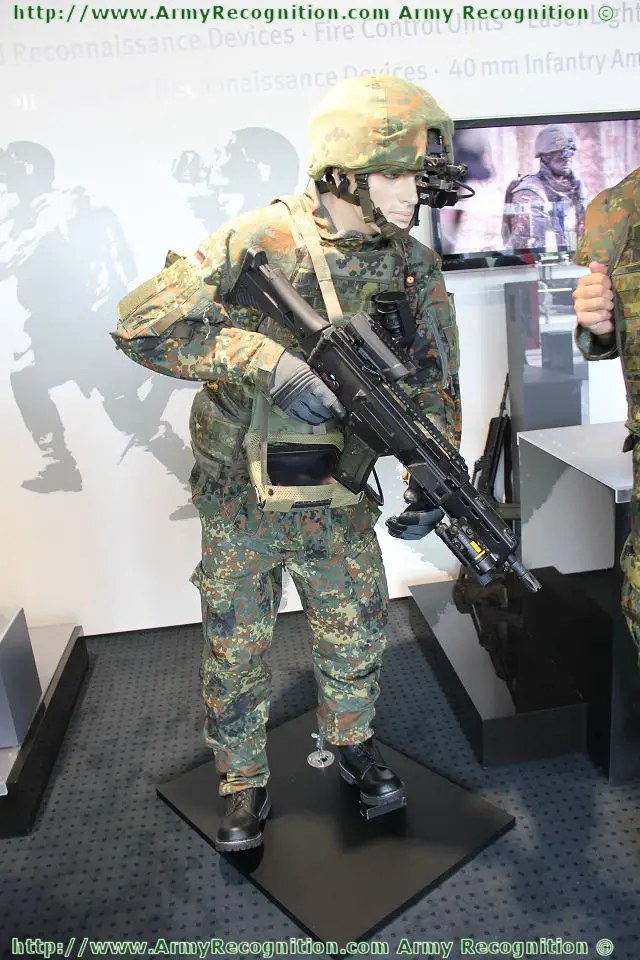| Like
its namesake, the trusty Roman short sword, Gladius is intended to give
the infantryman a decisive edge on the modern battlefield. The system
enhances the performance of dismounted forces in the following capabilities
categories: command and control, combat effectiveness, survivability and
protection, sustainment and mobility. It brings infantrymen on the ground
directly into the network-enabled warfare loop.
The operational requirements for a soldier system vary from one branch
of the military to another. Paratroopers, for example, traditionally have
to be able to operate independently behind enemy lines, or - the more
likely scenario today ¡V deploy to rescue civilians stranded in
crisis zones abroad. Other infantry units - those specializing in mountain
warfare, for example, or mechanized operations - have other requirements.
Gladius thus had to meet the operational needs of a variety of highly
specialized units. Moreover, the soldier system was expected to enhance
command and control capabilities, mobility and survivability.
In order to meet these requirements, Rheinmetall pursued a holistic approach
in which the individual system components interoperate in optimum fashion,
in turn assuring a significant improvement in the efficiency of each individual
component.
Extensive components
Rheinmetall's system approach seeks to integrate the (complete infantry
system) - i.e. the 10-man infantry section or squad with its vehicle -
into the network-enabled warfare loop.
Gladius is the first soldier system that directly connects the infantry
section to the next higher echelon, enabling exchange of voice and data
communication and assuring the link to the German Army¡¦s
Command Information System (FuInfoSysH).
This requires a comprehensive array of technical equipment. The components
that are combined to create the system fall into three basic subgroups:
-Battle dress, body armour and harness,
-Wepaons, optics and optronics (WOO), and
-C4I = command, control communication, computers, information.
The core system and helmet system constitute the heart and soul of Gladius.
They include the ¡§electronic backbone¡¨ into which
the chief components are integrated. The core computer is based on the
Linux operating system; via various interfaces, it controls all the different
devices and sensors the soldier carries with him. The soldier operates
the core computer with the control unit with integrated display. Using
this device, he can also access tactical information. Alternatively, he
can make use of the helmet display (SVGA), which displays all the relevant
data concerning the situation, the position of friendly forces (GPS and
inertial navigation are both available), his mission and the status of
the system.
The current tactical situation is continuously and automatically updated,
helping commanders to make decisions as well as making it easier to coordinate
the deployment of friendly forces. An integrated Blue Forces tracking
function indicates the position of friendly troops, enabling the section
leader to visualize and evaluate the situation on the ground. Via the
command system, the individual troops receive precise movement orders
from the section leader, which are simultaneously displayed on the map.
Particularly when the section is spread out over a large area, it is also
possible to issue additional graphic orders to support communication inside
the section. The section leader has the option of quickly sketching graphic
orders or positions on the operations map. Alternatively, he can also
issue abbreviated orders or pre-formatted messages via the command system.
This saves precious time in critical combat situations.
For night operations, it is possible to exchange the helmet display for
Lucie IID night vision goggles, which offers obvious advantages. This
enables the infantryman to access and exploit all the command information
described above while operating in full night-fighting mode. In conditions
of reduced visibility, the command system greatly facilitates target allocation,
identification of other soldiers from the section or finding orientation
points.
An audio headset with built-in hearing protection not only enables direct
voice communication, but also filters out harmful impulse noises while
still permitting the wearer to hear quieter ambient sounds.
Wireless concept
The section leader and deputy section leader are both issued with an additional
leader¡¦s set that essentially consists of a portable command
computer and command radio for long range communication.
In order to enable communication within the section, the current solution
concept envisages using broadband UHF, supplemented with a VHF link. The
section is linked to the external command system via the vehicle. The
current version of Gladius makes this possible for the first time.
|
| Key
advantages of Gladius
The considerable operational added value of Gladius results in part from
bridging previous capabilities gaps, especially with regard to C4I, network-enable
warfare and combat effectiveness. Examples include:
-Improved situational awareness and expanded command and control capabilities
due to Blue Force tracking and Red Force visualization;
-Augmented reality day and night with integrated C2 information for enhanced
combat performance;
-Real-time transmission of information from soldiers to the command post;
-Rational harmonization of uniforms, body armour and load carrying system.
This enables soldiers to adjust to ambient temperatures ranging from -32°C
to +45°C. They offer protection from optical detection and the elements,
and can be upgraded from German protection class (SK) 1 (an inconspicuous,
normal battle dress uniform) to protection class SK4, which features modular
body armour inserts. The latter can also be worn in tactical vehicles,
which makes exiting the vehicle under fire considerably less hazardous;
-Optimized ergonomics (easy to use under field conditions, comfortable
to carry, etc.), coupled with high mobility: (equipment tailored to mission).
The innovative ventilation shirt makes a significant contribution to sustainment.
Combining a high degree of modularity and flexibility with the systematic
use of standard interfaces assures fast, economical retrofitting and reconfiguration
in response to changing tactical requirements, making Gladius a reliable,
future-proof investment. By using the Gladius the infantry achieves a
tremendous enhancement of their operational effectiveness in combat missions. |

















